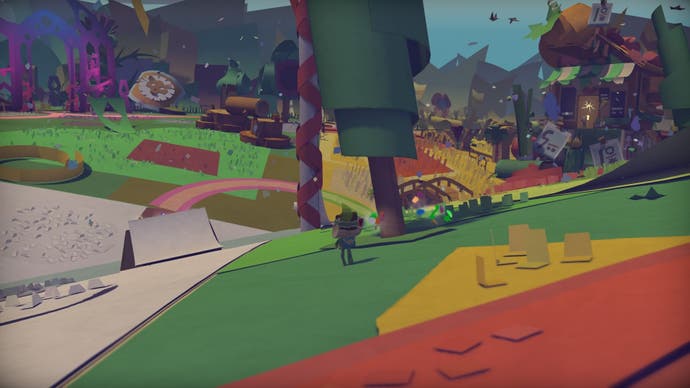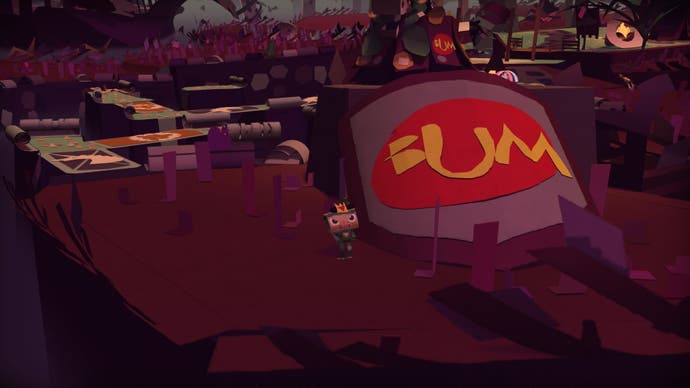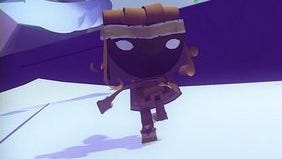Tearaway Unfolded review
Paper view.
As Sony's last-gen library slowly but surely makes its way to the PlayStation 4 in remastered form, award-winning Vita curiosity Tearaway was surely the least likely candidate for the port treatment.
It is, after all, a game that was designed from the ground up to be a Vita exclusive, building not only its controls but its core gameplay around the front and rear touchscreens, the cameras and all the other features that only the Vita offers. Surely transplanting the game to PlayStation 4, to be played via joypad and TV, would mean excising so much of what made Tearaway so magical?
In theory, yes. In practice, no. Tearaway was built from the ground up for the Vita, and so Tearaway Unfolded has been rebuilt for the DualShock 4. This is much more than a spruced up remaster. This is a bottom to top remake, with entirely new gameplay mechanics and large sections of the game changed completely to accommodate them.
The core, however, remains the same. Controlling either Aoti or Iota, two envelope-faced messengers, your aim to reach a tear in the sky of their whimsical papercraft world. Peering in through this tear is The You, as in literally you, the player, using the PlayStation Camera as a portal through which you become a godlike figure to the characters.
In the original game, your deity-like powers involved poking your fingers into the world using the Vita's rear touchscreen, and grabbing and pulling the scenery with the front screen. Although the DualShock 4 has one small touchpad, Media Molecule has instead opted to create entirely new ways to interact with with Aoti and Iota's world.

The first you discover immediately. Holding down R2 shines the motion-sensing light from your joypad into their world. You guide it around by tilting the controller, and use it to illuminate dark places, waking up sleeping foliage and burning away the drab newspaper textures that infect the world because of the Scraps, the monocular cardboard enemies who have poured through the portal in the sky. You can also use the light to hypnotise the Scraps, and lead them wherever you want. In this fashion, you can make them fall off ledges or topple into traps.
Another of your abilities allows you to create gale force wind, swiping across the DualShock 4 touchpad to send gusts in whatever direction you want. Again, this has its uses in combat - sending enemies caught mid-jump flying off-screen - but is mostly used to unfurl the paper environment into ad hoc platforms. There are entirely new sections of the game built around this idea, with maze-like traversal puzzles where you must keep changing the direction of the wind to bridge different gaps and mountainous areas where you must blow banners and flags horizontal to cross terrifying drops.
All told, while the basic structure of the game remains the same, visiting the same areas in the same order, they are so often changed completely by the new gameplay mechanics that Tearaway Unfolded teeters on the brink of being a completely new game. I certainly found myself alternating between the PS4 and walkthrough videos of the Vita version, as I tried to work out where the changes had been made. So much of Unfolded feels so organic, so naturally a part of the game, that I doubted my own ability to remember if they'd been there all along.
Other elements are definitely the same. The in-game camera returns, letting you snap plain white objects hidden in the scenery, colouring them in and unlocking them as physical papercraft printouts at the Tearaway.me website, and is much the same in both form and function.
Identical, too, are the customisation options which let you draw and snip your own designs for use in the game world. Many of the game's optional objectives revolve around this sort of creativity, as you're asked to craft butterfly wings and snowflakes which will then be seen throughout the game, or a crown for King Squirrel which recurs every time he is seen.
That's still one of the most delightful aspects of Tearaway, and its appeal is undimmed in Unfolded. Kids, in particular, will be thrilled at the way the game weaves their creations into its fiction. Even as a crusty old adult, I was continually charmed whenever I noticed something I'd made hours earlier still appearing in the background.
The actual creation process is slightly diminished though. Drawing outlines with your finger on the DualShock 4 touchpad is quite fiddly, more due to its small size than lack of sensitivity, and I found some of the more intricate requests annoying rather than inspiring as a result. There's an attempt to balance this out by letting you use the PlayStation companion app on a tablet or phone to do the creative stuff - a second player can also join in this way - but it's a somewhat clumsy (and expensive) solution to one of the few Vita to PS4 problems that Unfolded never fully solves.
It's also true that for all its wonderful generosity in recreating the game afresh for the new hardware, Tearaway on the PS4 is never quite as wonderfully immersive as its Vita original. That's just an inevitable side effect of the technology - this is no longer a world you literally hold in your hands, putting your fingers "inside" the scenery and moving it around. Your role as a god of magical lights and summoned winds is, by necessity, a more distant and aloof one.

This is echoed in the use of the camera. On the Vita, it naturally captured your face in close-up, and you could see yourself in the sun, looking back. Nobody plays their PS4 with their face a few inches from the camera, however, so what you most likely get instead is a view of your living room hovering in the sky, sitting on your sofa like Odin on some unusually comfy Olympian throne. Thanks to the way my home office is set up, I actually spent most of Unfolded with a view of my knees - or, on several worrying occasions, my manspreaded crotch - floating in the virtual sky.
Addressing this sense of distance, another new ability allows you to throw objects and enemies out of the screen and into the DualShock 4, from where they can be shot back into the game at high speed. This is probably the game's best bit of fourth wall breaking innovation, familiar though it is from the AR Bots in the PS4 Playroom, and the fact that you can "stroke" the touchpad to tickle squirrels and gophers who audibly skitter and squeak from inside the controller is the sort of thing Media Molecule does so well.
Converting such a singular game to an entirely new control scheme and console set-up was always going to be a mammoth task, and please don't mistake a few minor stumbles as evidence that Media Molecule hasn't pulled it off. There's passion and care in every pixel of Tearaway Unfolded, a burning desire to do the game justice in its new home even if it means reworking huge chunks of the game, and the experience is as beguiling as it ever was. Indeed, now viewed on a large TV screen, it often looks even more gorgeous than ever before.
Visual improvement is usually the only real reason to pick up remastered versions of old games, but Unfolded goes one better. The fact it looks better is merely an attractive bonus. Even if you've already played the original game through to completion, it's absolutely worth playing it again in this incarnation.




